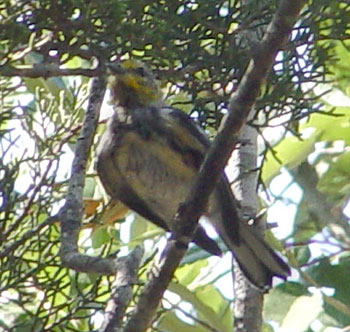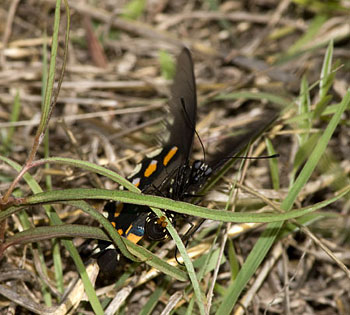Archive for '2008 Journal' Category
Very dry and windy. Used the water mister for birds.
- 8am, saw Wild turkey in driveway walking to water guzzler
- Refreshed all hummingbird feeders and used olive oil on the yellow feeding ports to deter bees
- Saw anoles mating, green male and brown female
- Saw a lizard leap and grab a brown and gray mottled moth, it spit it out and the moth flew away.
Posted in
2008 Journal, Census, Food, Water
- Many cardinals benefiting from water spray
- Saw possum
Posted in
2008 Journal, Census, Water
Worker saw a male Golden-cheeked Warbler feeding a young fledge and and caught this image of the young bird.

Caretaker's note: It is an excellent sign to see an endangered Golden-cheeked Warbler but even better to know that they are breeding successfully! This photo clearly shows the "golden cheeks" on the young fledgling's head. While this is not the best photo of the Golden-cheeked Warbler, it is included here as a document of the sighting. This photo was taken by Mike Jones.
Posted in
2008 Journal, Census
- Fewer hummingbirds and bees seen
- Saw Painted bunting
- Saw a duck on the river
- Saw Great Blue heron
- Ceraunus butterfly
- Southern yellow jackets and red wasps were seen hunting caterpillars
- Many frogs and toad tadpoles
- Saw a skink
- Saw a striped racer lizard with no tail
- Saw 2 juvenile Nine-lined racer lizards
- Saw juvenile anole
- Bobcat seen hunting birds at feeding station
Added large juniper stumps around bird feeding area to provide security for small birds and animals and deter deer.
Posted in
2008 Journal, Census, Habitat, Predator
Swanflower found and saw the Pipevine Swallowtail butterfly laying eggs on it. This is how caretakers were able to identify the Swanflower that is well camouflaged in native grasses.

Caretaker's note: Pipevine Swallowtail butterflies have been found for many years on the land. The Swanflower is the host plant for this species. The Swanflower looks very much like any other grass, but on closer examination has distinct characteristics. It is also known as the Dutchman's Pipevine, because of the unusual flower shape that is similar to a smoking pipe.
Posted in
2008 Journal, Census, Habitat
<< Previous Entries


